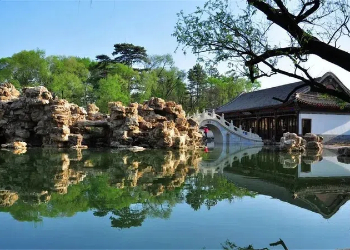 The Lion Grove Garden
The Lion Grove Garden
Lion Grove Garden, one of the Four Famous Gardens in Suzhou, enjoys the reputation of being the "Kingdom of Rockeries". Its history can be traced back to the Yuan Dynasty, with a history spanning over 650 years, making it an outstanding representative of Yuan Dynasty garden art. Despite its modest size, Lion Grove Garden has become a shining pearl in Chinese classical gardens due to its unique gardening techniques and exquisite landscape design.
Lion Grove Garden is renowned for its rockeries, which feature undulating peaks, a magnificent atmosphere, and winding caves and valleys. The rockery complex boasts nine routes and 21 entrances, horizontally twisting and turning, and vertically rising and falling. Visitors traversing the caves will find themselves winding left and right, sometimes ascending to peaks and sometimes descending into valleys, as if entering deep mountains and steep ranges. Suddenly, they may find themselves in open spaces, and then plunge into deep seclusion, creating a mesmerizing and enigmatic experience. The garden is also adorned with ancient and famous trees, exquisite pavilions, winding caves, jagged rocks, beautifully crafted scenery, with every corner filled with poetic and picturesque charm.
History of the Lion Grove Garden
The history of Lion Grove Garden in Jiangsu Province can be traced back to the Yuan Dynasty, and here is a detailed review of its history:
Establishment and Changes
Establishment Period: In the second year of Zhizheng in the Yuan Dynasty (1342), Lion Grove Garden was built by the disciples of Master Tianru in memory of their teacher. It was initially named "Lion Grove Monastery," and later renamed "Pujiti Zhengzong Monastery" and "Shengen Monastery." The garden was named "Lion Grove" because it had ten thousand bamboo trees, and under the bamboo were numerous strange rocks shaped like lions (Suanli in Chinese), and Master Tianru, in honor of Buddhist succession and the transmission of dharma, chose the meaning of the Lion's Seat in Buddhist scriptures.
Desertion and Reconstruction: During the late Yuan and early Ming dynasties, after Master Tianru passed away, his disciples dispersed, and the monastery and garden gradually fell into desolation. In the sixth year of Hongwu in the Ming Dynasty (1373), the great painter Ni Zan passed through Suzhou and participated in the creation of the garden, composing poems and paintings (including "Lion Grove Garden"). By the Kangxi period, the monastery and garden were separated, and later bought by Huang Xingzu, the prefecture chief of Hengzhou and father of Huang Xi, who named it "She Garden." In 1771, Huang Xi became the top scholar in the imperial examinations, refined his mansion, and reorganized the courtyard, naming it "Five Pines Garden."


Modern Protection and Restoration
Purchase and Restoration by the Bei Family: In 1917, Bei Runsheng, a giant merchant of pigments in Shanghai (and the great-uncle of the world-renowned architect I.M. Pei), purchased Lion Grove Garden from Li Zhongyu, the Director of Civil Administration, and spent nearly seven years restoring it, adding new attractions, and reverting to its old name "Lion Grove Garden." Bei Runsheng originally intended to prepare for its opening, but was unable to do so due to the outbreak of the war.
Donation and Opening: After Bei Runsheng passed away in 1945, Lion Grove Garden was managed by his grandson Bei Huanzhang. In 1953, Bei Huanzhang and his relatives donated Lion Grove Garden to China. In 1954, the main parts of Lion Grove Garden and the ancestral hall were repaired and opened to the public.
Historical Status and Value
Cultural Heritage: Lion Grove Garden is one of the representative classical gardens in Suzhou, a national AAAA tourist attraction, and included in the "World Heritage List." It boasts the largest existing ancient rockery group in China, with lakeside rockeries that are superbly crafted and hailed as the "Kingdom of Rockeries."
Heritage Protection: In 2006, Lion Grove Garden was announced as the sixth batch of National Key Cultural Relics Protection Units by the State Council of the People's Republic of China.
Information
Name in Chinese: Lion Grove Garden
Entrance Fee: 40 yuan during peak season, 30 yuan during off-peak season
Recommended Visit Duration: 3-4 hours
Opening Hours: Peak Season: 7:30-17:30 (March 1st - October 31st); Off-Peak Season: 7:30-17:00 (November 1st - February 29th)
Travel Tips
Wear Comfortable Clothing: As mentioned earlier, Lion Grove Garden contains many rockeries and footpaths, requiring long periods of walking, so it is recommended to wear comfortable shoes.
Sun Protection and Heat Prevention: During summer visits, please pay attention to sun protection and heat prevention, and bring essentials such as sun hats, sunglasses, and water bottles.
Keep Quiet: During your visit, please keep quiet, do not shout loudly or litter, and respect cultural relics, historic sites, and the natural environment.
Safety First: Especially when climbing mountains and passing through narrow footpaths, be sure to be cautious of slippery surfaces and prevent falls to ensure your own safety.
Learn About History: To better understand the history and culture of Lion Grove Garden, it is recommended to hire a tour guide or use a self-guided audio tour device. These services can help you gain a deeper understanding of the background and stories behind each attraction.
Lion Grove Garden, with its unique gardening techniques and exquisite landscape design, has become a shining pearl among Chinese classical gardens. Whether you are a lover of garden art or a seeker of historical culture, Lion Grove Garden is a must-visit tourist destination. Let us take an exploratory mindset, step into Lion Grove Garden, and feel the classical beauty that transcends time and space!




































